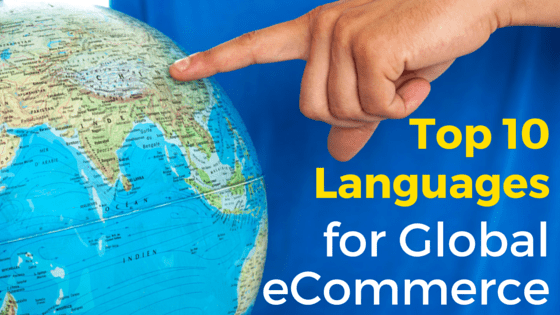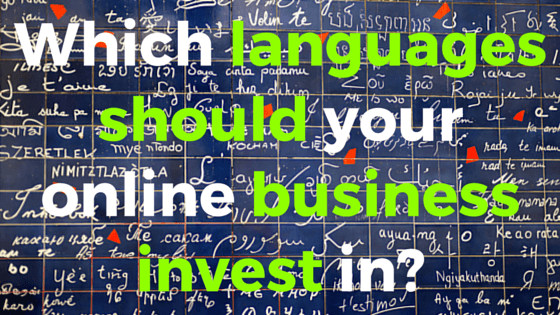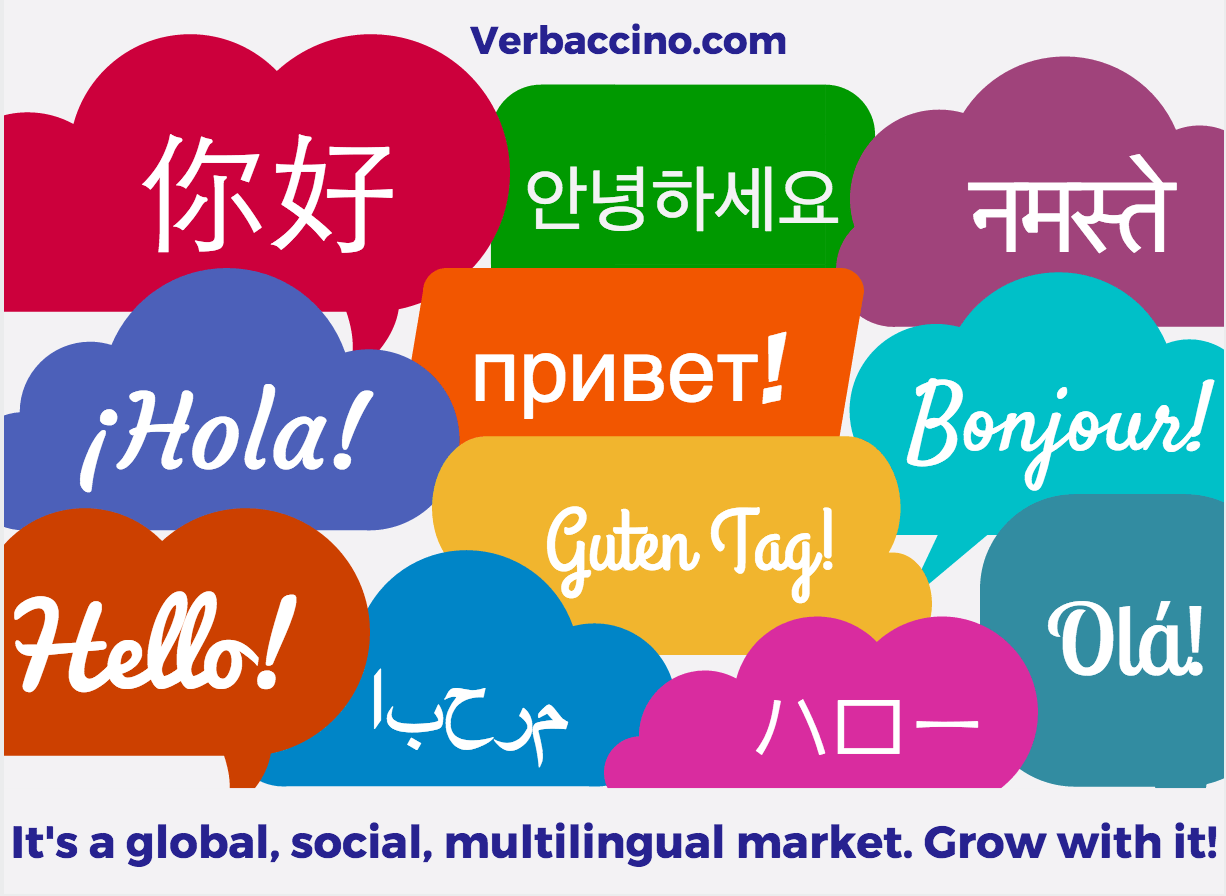Do have an online business? Are you trying to grow a more international customer base? Smart thinking. We all know that the Internet is a much bigger, much more diverse place than it was even 10 years ago. According to Internet World Stats, there are now 3,345,832,772 active Internet users in the world. That’s over 3 billion – almost half the global population. Of those Internet users, only 9.4% are in North America, even though it’s the continent with highest penetration rate (88%). So where are the other 90.6% of the world’s Internet users? And what languages do they speak?

Currently, about half (48.1%) of all Internet users are in Asia ; nearly a fifth (18.1%) are in Europe; another 10.1% are in Latin America and the Caribbean; 9.8% are in Africa; 3.7% are in the Middle East; and 0.8% are in Oceania and Australia. Surely, these millions and millions of Internet users speak a wide range of mother tongues.
And yet, if you look at W3Tech’s December 2015 ranking of languages according to the amount of published web content available, you’d be forgiven for thinking that the majority of Internet users are English speakers:
- English – 54.1%
- Russian – 6.1%
- German – 5.7%
- Japanese – 5.0%
- Spanish – 4.8%
- French – 4.1%
- Portuguese – 2.6%
- Chinese – 2.1%
- Italian – 2.1%
- Polish – 1.9%
The list goes on, into ever smaller fractions of 1%. Remember: these percentages represent the distribution of global web content according to language of publication.
When I first came across these numbers, I was rather shocked at the disproportionate amount of English content, compared to every other major world language. OK, maybe I shouldn’t have been be shocked. After all, English has functioned as the lingua franca of the Internet from its early days, back in the 1990s.
But times are changing, and the question is: to what extent do these statistics represent the billions of people who are online now, looking for content in their native language? How well does this available web content serve today’s rapidly growing and global Internet community? In 2016 and beyond, is it still reasonable to assume that English-language content will be understood – let alone preferred – by a majority of the world’s Internet users?
From an eCommerce perspective, wouldn’t a multilingual strategy make you more competitive and create better growth opportunities? If so, which languages should your online business invest in?

First, let’s take a look at world languages in general. Which languages have the largest number of native speakers, regardless of Internet usage? According to Ethnologue, the 10 most common native languages in the world are currently:
- Chinese* – 1,197 million speakers (via China, Hong Kong & Taiwan)
- Spanish – 399 million speakers (via Spain & Latin America)
- English – 335 million speakers (via UK, USA, Canada, Australia, etc.)
- Hindi – 260 million speakers (via India)
- Arabic – 242 million speakers (via Western Asia & North Africa)
- Portuguese – 203 million speakers (via Portugal & Brazil)
- Bengali – 189 million speakers (via India & Bangladesh)
- Russian – 166 million speakers (via Russia & other post-Soviet states)
- Japanese – 128 million speakers ( via Japan)
- Lahnda – 88.7 million speakers (via Pakistan & parts of India)
*Chinese is really a group of related languages, the most common of which is Mandarin with ca. 848 million native speakers. That’s still more than double the number of native Spanish speakers (#2 on the list).
So how many of these speakers are actually online? Let’s look at the statistics for specific countries. According to the most recent numbers reported by We Are Social, the 10 countries with the largest number of active Internet users are:
- China – 668 million users (49% penetration) – Chinese dialects
- India – 350 million users (27% penetration) – Hindi, Bengali, Lahnda
- U.S.A. – 280 million users (87% penetration) – English
- Brazil – 110 million users (54% penetration) – Portuguese
- Japan – 109.6 million users (86% penetration) – Japanese
- Russia – 87.5 million users (60% penetration) – Russian
- Indonesia – 72.7 million users (28% penetration) – Indonesian
- Germany – 71.7 million users (89% penetration) – German
- Nigeria – 70.3 million users (38% penetration) – Hausa, Yoruba, Igbo
- Mexico – 59.2 million users (49% penetration) – Spanish
For each country, I’ve provided the main native language(s) in italics, so you can start to see the overlap with the previous list.
Not surprisingly, on both lists, Chinese speakers dominate by a huge margin. Notice also that the U.S. is the only country in the top 10 where English is the main native language.
Now let’s look at the Internet penetration rates, i.e. the percentage of a country’s population who are active Internet users. Not surprisingly, it’s in non-English-speaking countries (China, India, Brazil, Indonesia, Nigeria and Mexico) that we find the most room to grow in terms of numbers of Internet users. And those countries have already boasted some of the fastest growth rates of the past decade and a half.
Consider this: between 2000 and 2015, Internet usage increased by 1,309.4% in Asia; by 1,777.5% in Latin America and the Caribbean; by 3,649.8% in the Middle East; and by a whopping 7,146.7% in Africa. Meanwhile, the growth rate in North America was 190.4%.
With millions of new users gaining access to Internet every year, the world of business can’t help but be transformed. eCommerce has become a truly global phenomenon, one that is here to stay. And the revenue pie is growing every year.
For 2014, eMarketer reported that retail products and services purchased on the Internet totalled $1.343 trillion USD worldwide. Who were the biggest online spenders? The top 10 countries in terms of eCommerce revenue were:
- China – $426.26 billion USD (Chinese)
- U.S.A. – $305.65 billion USD (English & Spanish)
- U.K. – $82 billion USD (English)
- Japan – $70.83 billion USD (Japanese)
- Germany – $63.38 billion USD (German)
- France – $38.36 billion USD (French)
- South Korea – $33.11 billion USD (Korean)
- Canada – $24.63 billion USD (English & French)
- Russia – $17.47 billion USD (Russian)
- Brazil – $16.28 billion USD (Portuguese)
Based on current projections, this ranking will remain similar for 2015, except that the total revenues generated will be even higher: an estimated $1.672 trillion USD worldwide.
In terms of the percentage of a country’s population who made an online purchase within the past month, GlobalWebIndex gives the following numbers for Q4 2015:
- U.K. – 64% (English)
- Germany – 63% (German)
- South Korea – 62% (Korean)
- U.S.A. – 56% (English & Spanish)
- Australia – 51% (English)
- Canada – 49% (English & French)
- France – 49% (French)
- Singapore – 46% (Chinese, Malay, Tamil, English)
- U.A.E. – 45% (Arabic)
- Spain – 44% (Spanish)
This ranking may well shift over the coming years, as online shopping becomes increasingly popular around the world.
As the number of eShoppers grows, so does the number of eMerchants. To attract and retain customers, you now have to compete with businesses outside your own borders. One obvious way to be more competitive, then, is to reach out to customers in their preferred language. The often-cited 2014 report „Can’t Read, Won’t Buy“ by Common Sense Advisory makes this very clear.
So how multilingual does your eCommerce site need to be? Which languages are likely to provide the greatest return on your investment?

It really depends on the type of products or services you’re offering. Before you decide which languages to invest in, you’ll need to do some careful market research, so you can make an informed decision about which countries or world regions offer the best opportunities for your particular business.
That said, if your goal is to reach out to the greatest number of potential customers worldwide, here, for your consideration, is my current list of the top 10 languages for global eCommerce:
- Chinese
- Japanese
- German
- French
- Korean
- Portuguese
- Russian
- Spanish
- Hindi
- Arabic
You may decide to invest in one or more of these languages. Or you may find, after doing your research, that certain other languages, which didn’t make it into my „Top 10“, would actually make more sense for you.
In the end, no matter which languages you choose, always keep in mind: getting your content translated is just the first step. You also need to accommodate local cultural values, SEO, currencies, payment methods, etc. That’s why investing in localization can make all the difference, as I discussed in a previous blog post. Even speakers of the same language are often divided by their various dialects and cultures, especially when they are an ocean apart. Just think of „Old World“ European languages – like English, French, Spanish or Portuguese – versus their „New World“ counterparts.
Ready to think outside the English-speaking box and start building a more international brand? Excellent. Once you’ve identified the right foreign markets and the right translation and localization experts to help you get there, the world can become your eCommerce oyster.
Did you enjoy this blog post? Do you know someone who might enjoy it too? Why not share it using the social share buttons, below! Also, please don’t hesitate to send me your feedback. What are your thoughts on the topic? Share them in the comments section, and let’s start a conversation.
You can connect with Verbaccino on social media: LinkedIn, Twitter, Facebook, Pinterest, Google+ and Instagram.
For valuable tips on how to grow an international audience online, subscribe to Verbaccino’s monthly newsletter, The Worldly Marketer. It’s free!

Kommentare geschlossen.